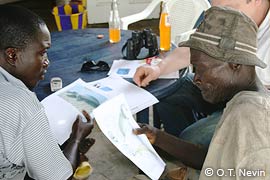

 |
||
 |
||
Vol. 8 (2): December 2005 |
||
Mediterranean monk seal off Ginak Island, The Gambia:
|
 |
|
|
|
Mr Jammeh confirmed that West African Manatee, Atlantic Humpback Dolphin and a range of marine turtle species were present; carapaces of Green and Olive Ridley were identified and Leatherback was convincingly described. He also confirmed that he was familiar with Monk Seals and that he had observed them many times. To try to rule out misidentification or falsification, he was asked how seals differed from manatees, a species he was clearly very familiar with. He pointed out that they had a different shaped tail, ate fish, were more “aggressive” and were found around rocky areas and caves. The latter point was of particular interest as it may indicate a breeding population. When further questioned about the caves it was not clear whether he was referring to caves on land or caves in rocky areas underwater. Although we explained to our interpreter that it was important to distinguish between caves that might be suitable for breeding and caves meaning underwater rocky areas, difficulties in translation led us to conclude that we could not be certain that Mr Jammeh was referring to suitable breeding areas. In view of the sensitivity of much of the information we had received, and the fact that we knew we would return in the winter of 2005/2006, we did not push this issue any further.
From the interview, we concluded that Mr Jammeh was familiar with monk seals and that this species was regularly present in the area around Niumi National Park. As part of the University of Central Lancashire’s Project Gambia, it is anticipated that a fuller picture of the status and distribution of monk seals in The Gambia will be gained in the winter of 2005/2006. To achieve this, boat, questionnaire and shoreline surveys are planned and identification charts will be distributed to fishermen and visiting naturalists with an in-country address for reporting sightings.
Van Waerebeek, K. et al. 2001. WAFCET 1 Report. A survey of the conservation status of cetaceans in Senegal, The Gambia and Guinea-Bissau. Cetacea Informa 10 (18): 36-38.
Copyright © 2005 Dr. Roy Armstrong, Dr. Owen T Nevin, The Monachus Guardian. All Rights Reserved |